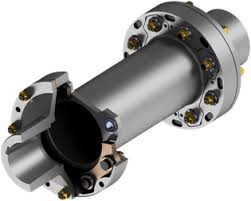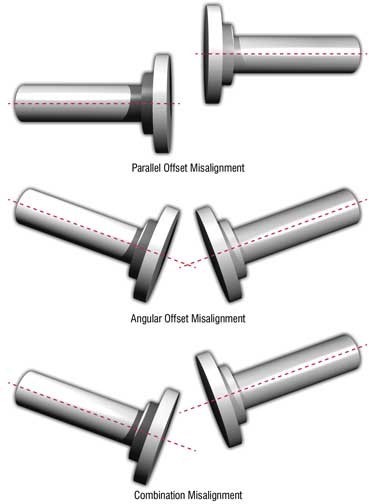In an ideal world, multiple components could be produced in a single piece, or coupled and installed in perfect alignment. However, in the real world, separate components must be brought together and connected onsite. Couplings are required to transmit rotational forces (torque) between two lengths of shaft, and despite the most rigorous attempts, alignment and lubrication is never perfect.

Misalignment
Misalignment can occur as either an offset or as an angular displacement on two of the possible three axes. The third axis, in the longitudinal direction, is not commonly measured, though errors in this direction can result in constant excessive thrust loads in a system.

For major installations, such as large compressors, wire alignment methods are used. Smaller applications have traditionally used rim dial indicator readings to quantify and correct misalignment, though optical laser indicators are rapidly gaining in popularity due to their ease of use and accuracy.
Efforts are also made to compensate for thermal growth that occurs in equipment during operation.
Attempts are made to preheat or cool equipment to normal operating conditions before performing alignment checks. Alternatively, calculations of anticipated thermal growth can be used.
Whatever precautions are taken to make alignments as precise as possible some amount of residual misalignment will inevitably remain. Misalignment forces rigid machine components such as shafts to deflect in order to effectively become aligned.
This deflection stresses the components, causes vibrations, and distributes higher and uneven loads on the structures that support these elements, such as bearings. These stresses can dramatically reduce equipment life and reliability.
Designed properly, couplings can absorb misalignment forces so that more expensive, critical, and sensitive components may be saved. While rotating shafts appear sturdy, the bearings which support them are some of the most sensitive precision components in the drive train.
Maintenance Recommendations
Acceptable life can be expected from any of these devices only if proper maintenance is performed. Lubricant levels and quality must be verified through periodic checks and appropriate actions must be taken. Gear couplings require perhaps the most maintenance. Typical relubrication intervals are six months to one year, depending upon application severity and stuff experience.
All maintenance tasks must be performed with attention paid to lubricant contamination control.
Improper removal of solvents used to clean couplings during inspections and flushing operations can lead to significant viscous thinning of the lubricant in operation, or detrimental reactions with grease-thickening materials.
All couplings will endure significantly better when the demands placed on them are reduced. Consider the first line of defense to be a minimization of shock loading, including hard starts and sudden load reversals. Sometimes operational demands make this impossible. The principal source of loading in coupling systems can be controlled to a great extent, however. Proper alignment is considered a high-priority, precision maintenance functions.
Use vibration analysis, airborne ultrasound directly in the area of the coupling and thermography during operation to identify couplings that are not in alignment, as even the sturdiest foundations shift over time. Certainly, check for proper alignment whenever intrusive maintenance or repairs are performed on the coupled components.
